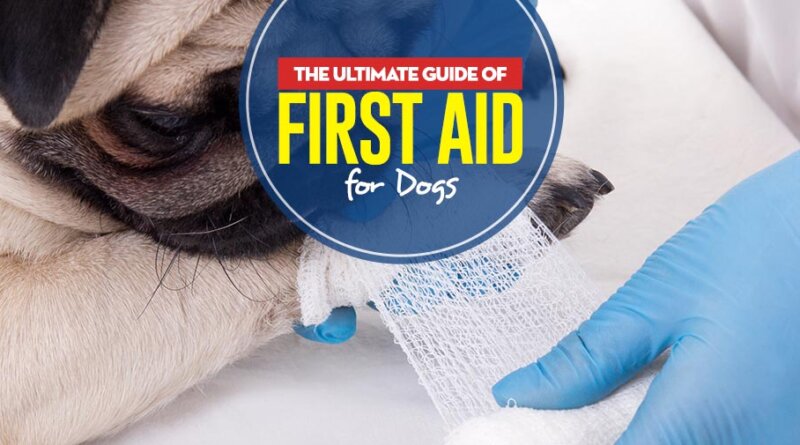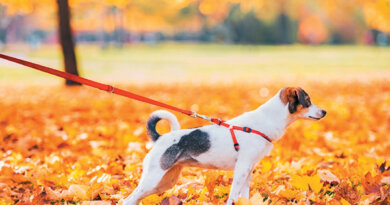8 Vital Things Every Dog Owner Must Know and Do
Many have a first aid kit in bathroom cabinets for emergencies but have you thought what you’ll do to provide first aid for dogs? Having a pet first aid kit is just the first step, and there several things you need to know for using the kit and first aid techniques in case of a dog emergency.
The key to providing first aid to dogs is to save time before professionals arrive. If the dog is choking or got poisoned, you cannot be searching for items or advice online while your dog is grasping for breath, bleeding, is in pain or worse. However, no first aid for dogs done by yourself at home should be a substitute for proper veterinary care.
The Guide to First Aid for Dogs
1. Basic Canine Health Knowledge
To monitor your dog’s health, you need to know what is normal. While all dogs differ as individuals, the data below is a good reference point for canine vitals. It would be best to copy it down and leave this information as a small pamphlet in your dog’s first aid kit.
Body Temperature
100.5° F to 102.5° F
Breaths Per Minute (Respiration Rate)
Puppies: 15 to 35 breaths per minute
Adult Dog: 10 to 30 breaths per minute
Beats Per Minute (Heart Rate)
Puppies: 120 to 220 BPM
Adult Dog: 60 to 140 BPM
Small Breed Adult Dog: 100 to 140 BPM
Large Breed Adult Dog: 60 to 100 BPM
2. Taking Your Dog’s Temperature
To determine whether your dog has a fever, you need to know the dog’s average “healthy” body temperature. Choose a few days when your dog is feeling well and take your dog’s temperature and figure out an average healthy temperature for your dog.
As your pet ages, their average daily temperature may change, so do this at least once a year. For small puppies and senior dogs, increase frequency to once every 6 months.
To get the most accurate temperature reading for your dog, you must take do it rectally. Invest in a traditional glass or digital thermometer and water based lubricant. Have someone hold your dog still while you put the lubricated thermometer 1″ to 2″ inside your dog’s rectum. Do not force the thermometer further than it will go easily.
Leave the thermometer in place for 2 minutes. Record this temperature. Thoroughly clean the thermometer and label it “For Dog”. Track your pet’s temperature at the same time of day for a few days to get an average normal body temperature reading.
3. Hypothermia and Hyperthermia in Dogs
You need to take a dog’s temperature to know when things like fever, hypothermia or hyperthermia sets in your pet. Quickly measuring the temperature can save your pet’s life. Below is how measure for most fatal temperature related health problems.
Hypothermia in dogs (low body temperature) is measured in stages.
Mild hypothermia
90˚F to 99˚F – use warm blankets, body heat, a covered heating pad, a hot water bottle, or warm drinking fluids to increase body temperature. Retake your dog’s temperature every 10 minutes until it comes up to 100˚F.
Moderate hypothermia
82˚F to 90˚F – Go to the vet or emergency vet immediately.
Severe hypothermia
Below 82˚F – URGENT care required.
Hyperthermia in dogs (high body temperature) should not be confused with a fever. A fever in dogs is their body’s natural immune response to eliminate bacteria or viruses. Hyperthermia is not caused by such a natural response and is often the result of a dog’s inability to thermoregulate.

Hyperthermia is classified when body temperature reaches or exceeds 103˚F due to thermoregulation issues. A fever is classified at 103˚F when the cause of temperature increase is due to immune response.
At 106˚F body temperature your dog is very likely to die.
In both types of overheating, it’s crucial to seek veterinary care. On the way to the vet, you can assist your dog by:
- soaking a clean towel in cool (not cold) water and laying it on your dog’s underbelly and inner thighs
- offer cool fluids – water, Pedialyte, electrolyte solution, etc…
- travel with the air conditioning on or windows open
- call ahead to let the vet know that you are coming
- massage your dog’s legs to assist circulation
- monitor your dog for signs of shock
3. Tracking Your Dog’s Breathing and Heart Rates
Normal body temperature, breathing and heart rates of your dog are the few vital signs that you must know really well when your canine is in a good condition. This is what will save your dog when the emergency situation arises.
Your dog’s breathing rate
Your dog’s average breaths per minute can tell you if they are having respiratory difficulty. Again, it’s important to know your dog’s average breaths per minute when they are healthy to determine when they are not.
Breaths per minute will change based on life stage, size, health and breed. Average breaths per minute should be taken at least once a year. Puppies, senior dogs, and dogs with chronic health conditions should have this done every 6 months or when change is noted.
To measure your dog’s breaths per minute, wait until he is at rest and breathing normally. Using a stopwatch, count the number of times your dog’s chest rises over the course of one minute. Repeat this over the course of a few days to get average breaths per minute figure for your dog.
Monitoring your dog’s breaths per minute is an important part of first aid for dogs. Any change in normal average breaths per minute may indicate circulatory or respiratory illnesses like pneumonia, heart disease, cancer, tumors or lung disease.
If you notice that your dog’s average respiratory rate increases or decreases drastically, continue to monitor it every minute for 5 minutes. If his respiratory rate continues to rise or fall rapidly, seek veterinary treatment immediately.
Your dog’s heart rate
Beats per minute tell you about your dog’s cardiac health and whether or not they are in crisis. Beats per minute vary greatly from dog to dog and are impacted by overall health condition, age, breed and size of the dog.
To measure your dog’s beats per minute, locate your dog’s pulse just behind the front left leg. Use your index and middle finger to monitor his pulse. Count the number of beats while you time a 15 second period.
Multiply this number by 4 to get the number of beats per minute. Repeat this daily over a few days to get an average BPM reading for your dog’s resting heart rate.
A change in your dog’s normal average beats per minute, that is not due to exercise, can indicate many things. These include tachycardia, allergic reaction, anxiety, shock, dehydration, heatstroke, heart disease among others. The list is extensive, and your veterinarian is the best resource to give you more details.
Monitor your dog for other symptoms that may indicate cause of the change, and contact your vet.
4. Bleeding Wounds
Bleeding wounds are one of the most common issues you’ll deal with when performing first aid for dogs. Taking care of your dog’s wounds properly and promptly is vital to avoid infections, and further complications.
If your dog has a mild cut or scrape, you need to clean the wound with warm water. Apply dog-safe antiseptic treatment, and then cover with a liquid bandage or put your dog in an Elizabethan collar or an inflatable collar.
If your dog has a more significant injury, head to the vet immediately. It would be best to take someone else with you, if possible. If you have that opportunity, have the other person drive so that you may tend to your dog.
If someone else is able to drive you, sit with your dog and apply direct pressure to the wound with a clean cloth. Keep the injured area elevated. If the bleeding is severe, apply direct pressure to the artery.
Apply pressure below and above the wound to control arterial and vein bleeding. DO NOT apply a tourniquet unless the injury is on one of the four legs or the tail. Even then, a tourniquet should only be used as a last resort to stop bleeding.
Pay attention to a dog’s behavior for signs of pain:
Dog going into shock
Excessive bleeding of your dog’s wound can lead him into a shock. You’ll need to monitor your dog for signs of shock, which include:
- drop in body temperature
- faint heartbeat
- old limbs
- pupil dilation
- shallow breathing
- pale mucous membranes (eyelids, gums, etc.)
If your dog shows any of these signs, keep them warm, monitor their breathing and pulse and administer CPR if necessary (we’ll discuss the steps for canine CPR in a moment). Stabilize any injuries, and do what you can to prevent further blood loss.
If your dog has a devastating injury with internal organs exposed, carefully wash any exposed organs with clean water as soon as possible. Soak a clean sheet in warm water and wrap it around the wound to contain the organs. Call your veterinarian immediately!
If there is someone else with you that is able to help, have them call your veterinarian as you perform first aid for dogs. Let the vet or emergency vet know you’re coming and your expected arrival time. Do not allow your dog to lick the area. Immobilize him if at all possible. Continuously monitor your pet for signs of shock.
5. Puncture Wounds
Puncture wounds have a few possible sources, all of which require veterinary attention. Most often, puncture wounds are from animal bites (dogs, snakes, etc.) or they are from foreign objects such as stepping on a nail.
If your dog has a puncture wound from an animal, veterinary attention is necessary to neutralize or treat any venom or bacteria injected into the wound. If your dog has stepped on an item like a nail, he should be assessed by the veterinarian. While lockjaw is rare and dogs are quite resistant to the bacteria that causes it, most veterinarians will give a tetanus vaccination just in case.
If your dog was bitten by an animal, get as much information about it as possible. For example, if it was a snake, what color was it? If it was a spider, can you safely trap it? Better identification makes for faster treatment.
If your dog was bitten by another dog, take the contact information of the other owner after performing first aid for dogs. Even better, see if you can take the owner with you to the vet. Find out if the other dog was up to date on vaccinations.
If your dog was bitten by a wild animal, did the animal show any strange behavior before biting? For example, an unnatural boldness around humans may be a sign that the animal was rabid.
Stabilize your dog if there is still an object lodged in the wound. Hold them as still as possible, and DO NOT pull the object out. Keep your dog as calm as possible. Likewise, keep your dog from licking the wound. If you must, use a muzzle or Elizabethan collar.
Again, monitor your pet for signs of shock. Puncture wounds are deep and the prime environment for deep infection. Always visit your vet for any puncture injury.
6. Hot to the Touch
If your dog has any area of their body that feels unusually hot to the touch (but has not been doing anything to cause this added heat) and seems unwell, they may have an infection. Check the area to ensure there are no puncture wounds or cuts.
If you see neither of these, there is no way to know the source of your dog’s infection. You must seek veterinary attention immediately!
In the meantime, keep your dog well hydrated. If he is reluctant to drink, offer low sodium chicken broth or Pedialyte. Keep your Fido calm and rested, and monitor your dog for other signs of health problems or illnesses, including lethargy, fever and anorexia.
No matter type of first aid for dogs you’re administering, DO NOT “wait it out”.
This is especially important if you have reason to believe that your dog has an infection. If the infection is generating heat, it’s severe enough to require immediate veterinary attention.
7. Obvious Break
If your dog has an obvious break to a bone, first aid for dogs cannot fix it. Immediate vet care is required. On the way to the vet, use a towel as a sling to lift your dog if the broken bone is a weight bearing limb. If the bone is visible through the skin, wrap the wound in clean gauze, a bandage or even a feminine sanitary napkin to keep the area clean.
Oftentimes dogs will become aggressive when they’re in pain. Muzzle your dog to prevent biting due to pain. Muzzling will also prevent your dog from licking or biting the effected area.
Do not apply any type of antibacterial or antiseptic to the wound. It will sting the wound and could cause an already agitated dog to become aggressive.
Do NOT touch the break or attempt to reset the bone yourself.
If you suspect that your dog has a potential fracture, you’ll still need to call your vet immediately. Without treatment, a fracture can develop an infection, set improperly or a piece of bone can break off and travel through your dog’s system. On the way to the vet, follow the same protocol as you would for a broken bone above.
8. CPR and the Heimlich Maneuver
Every dog owner should be certified in, or at least know how to do CPR for dogs. If you actually want to get certified, many organizations offer these classes online and some of them are even free. However, it’s best to attend one offered locally for hands on experience. You can find a Red Cross course close to you located here.

Be Safe and Stay Prepared
The first step in providing first aid for dogs is being prepared. Know the basics of care, get certified in first aid and be prepared with a fully stocked first aid kit. Plus, don’t forget to keep local emergency numbers on hand including the pet poison hotline, your closest emergency vet and your local vet clinic.
READ NEXT: How To Make and Use A Rear Leg Sling for Dogs (DIY Guide)













Kamagra 100mg price https://kamagra.icu/# – buy Kamagra